You can authenticate your wearable devices through ten innovative body gesture methods: punch gesture authentication using accelerometer data, arm movement pattern recognition during walking, PPG heart rate signature verification through optical sensors, ECG-based continuous cardiac monitoring, acoustic echo hand gesture detection, wrist rotation trajectory mapping, ring-based acoustic authentication, multi-modal biometric fusion combining multiple techniques, accelerometer motion profiling, and gyroscope-based movement analysis. These methods achieve 85-99% accuracy rates by analyzing your unique biomechanical patterns. Explore further to discover how each technology transforms your natural movements into secure digital keys.
Punch Gesture Authentication for Smartwatches
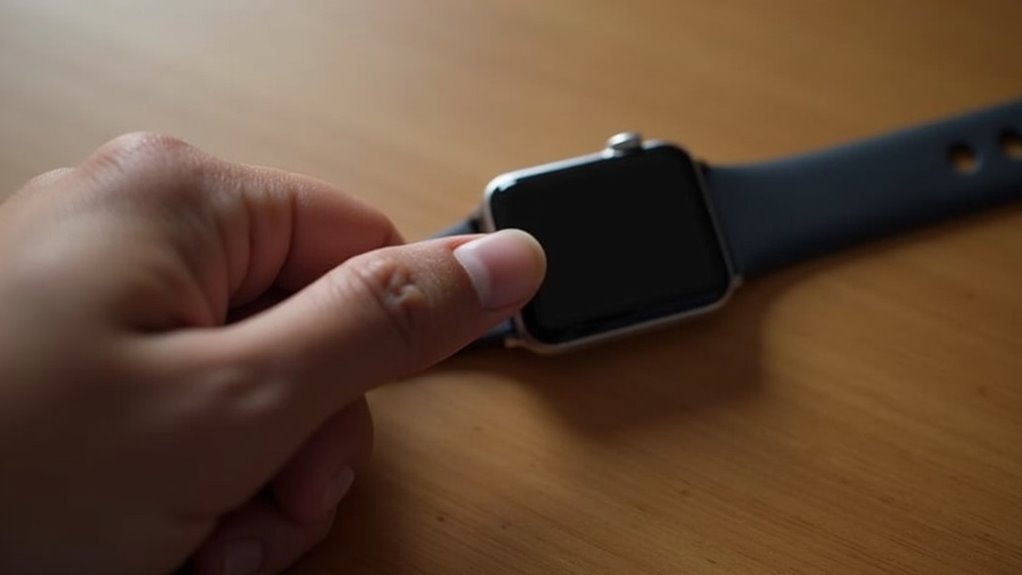
Anyone can throw a punch, but your smartwatch might soon recognize exactly how you throw yours. Punch gesture authentication uses your device’s accelerometer and gyroscope sensors to capture the unique patterns of your arm movement during a punch motion.
This biometric method analyzes how you subconsciously perform the gesture, creating a personalized authentication profile during enrollment.
You’ll find this approach convenient since it doesn’t require remembering passwords or PINs. The system works unobtrusively, allowing seamless authentication without additional effort.
While it’s promising for secure applications like banking services, challenges remain. Your punch might vary between attempts, affecting accuracy. Research shows that well-trained classifiers can achieve reliable results with a maximum of 25 samples for effective authentication.
Privacy concerns about biometric data storage and user acceptance of this unusual method also need addressing before widespread adoption.
Arm Movement Pattern Recognition Systems
When you move beyond single gesture authentication like punches, you’ll discover that continuous arm movement patterns offer a more sophisticated approach to smartwatch security.
Your natural walking gait creates unique arm swing characteristics that can be captured through accelerometer and gyroscope data, providing ongoing authentication rather than one-time verification.
You’ll find that these systems analyze your acceleration data profiles to build personalized movement signatures that distinguish you from other users throughout daily activities.
Punch Gesture Authentication
While traditional authentication methods rely on what you know or what you have, punch gesture authentication leverages who you’re through the unique behavioral patterns embedded in your arm movements.
When you perform a straight punch while wearing a smartwatch, inertial sensors capture your subconscious movement dynamics—velocity, angle, and motion nuances that distinguish you from others.
You won’t worry about shoulder surfing since there’s no exposed passcode. The system analyzes acceleration and motion data from your Samsung Gear Fit 2 or similar device, using machine learning algorithms to verify your identity.
Real-world testing with 20 volunteers and over 13,000 samples showed promising accuracy against imitators. You’ll appreciate the lightweight computation that enables continuous authentication without memorizing complex passwords or interrupting your natural workflow. Unlike explicit gesture systems, this approach provides continuous authentication while you perform other daily activities.
Acceleration Data Profiling
Behind punch gesture authentication lies a sophisticated process of acceleration data profiling that transforms raw sensor readings into unique behavioral fingerprints. Your wearable device’s accelerometer captures three-dimensional movement data from your wrist or forearm, recording the subtle nuances that make your arm movements distinctly yours.
The system extracts time-domain features like mean acceleration and variance, while frequency-domain analysis reveals the rhythm and periodicity of your gestures.
Dynamic Time Warping aligns temporal variations in your movement sequences, creating consistent user profiles despite natural timing differences.
Machine learning classifiers such as Support Vector Machines and Neural Networks process these features, achieving accuracy rates between 85% and 95%. Advanced squeeze-and-excitation mechanisms can further enhance the system’s ability to focus on the most discriminative movement features while filtering out noise from sensor data.
This continuous profiling enables real-time authentication that adapts to your natural movements while maintaining security.
PPG Heart Rate Signature Verification
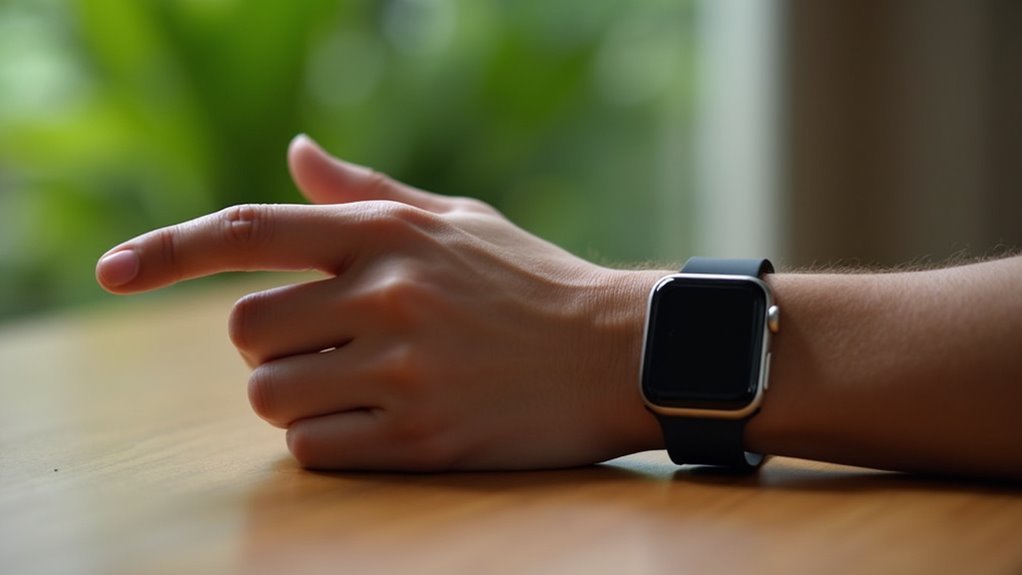
PPG heart rate signature verification transforms your unique cardiovascular patterns into a powerful authentication method for wearable devices. Your smartwatch measures blood flow changes through optical sensors, capturing distinctive waveform patterns and heart rate variability that act like your cardiac fingerprint.
This technology offers significant advantages over traditional biometrics—it’s nearly impossible to steal and provides live detection capabilities.
You’ll experience seamless, non-intrusive authentication without interrupting your activities. The TrueHeart system exemplifies this approach, enabling continuous verification through wrist-worn devices.
However, you’ll face challenges including signal quality issues from movement interference, sensor calibration requirements, and algorithmic complexity. The accuracy of these measurements can be further compromised by factors such as skin color, which affects how light reflects through blood vessels.
Despite these hurdles, PPG authentication enhances security for smart homes, workplace environments, healthcare monitoring, and financial transactions while maintaining user convenience.
ECG-Based Continuous Identity Monitoring
When your heart beats, it generates electrical signals that create a unique pattern as distinctive as your fingerprint. ECG-based wearable devices can continuously monitor these cardiac electrophysiology signals for persistent biometric authentication without interrupting your activities.
Unlike external biometrics, your internal physiological signals resist spoofing attempts, making ECG authentication highly secure. Modern wearable ECG systems use high sampling rates and multi-channel acquisition to improve accuracy while reducing false acceptance and rejection rates.
These devices combine ECG morphology with heart rate variability metrics to strengthen identity verification. You’ll find ECG authentication particularly valuable for protecting sensitive digital environments and physical access points.
The technology provides seamless, non-intrusive verification while simultaneously monitoring for cardiac abnormalities like atrial fibriation, delivering dual security and healthcare benefits. The continuous monitoring capability offers significant potential for reducing hospitalization expenses while providing reliable clinical diagnosis through wearable technology.
Acoustic Echo Hand Gesture Detection
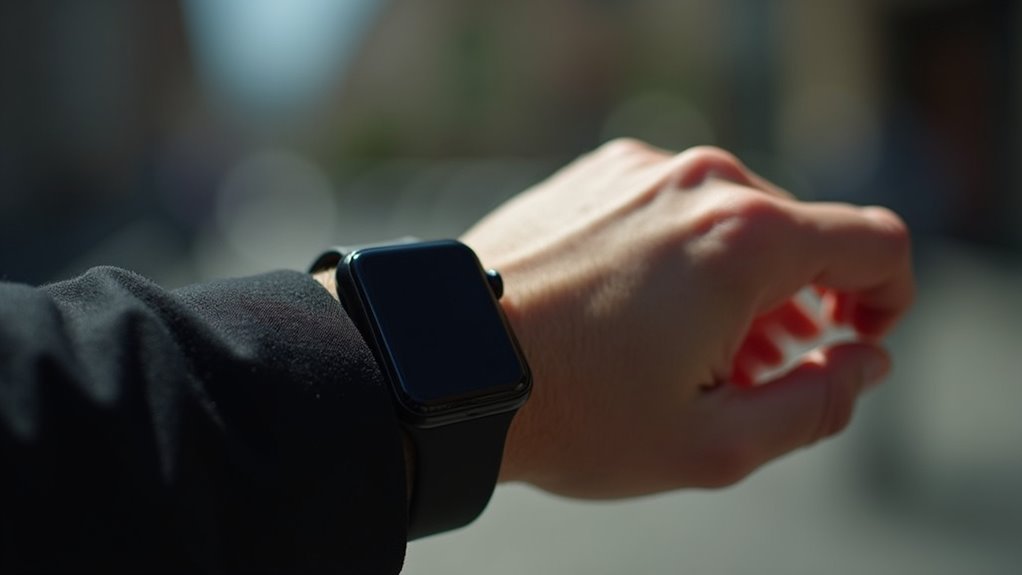
You’ll find that acoustic echo hand gesture detection relies heavily on echo phase signal processing to capture the subtle variations in reflected sound waves as your hand moves through different positions.
The system analyzes these phase shifts to create unique acoustic fingerprints that correspond to specific gestures you perform.
Modern implementations use CNN-BiLSTM authentication models that combine convolutional neural networks for spatial feature extraction with bidirectional long short-term memory networks to recognize temporal patterns in your gesture sequences. These systems can achieve remarkable precision in tracking, with devices like EchoWrist demonstrating mean joint estimation errors as low as 4.81 mm for 3D hand pose reconstruction.
Echo Phase Signal Processing
Rather than relying on cameras or touch sensors, echo phase signal processing leverages acoustic reflections to detect hand gestures for wearable authentication. Your hand movements alter how emitted sound waves reflect through space, creating unique acoustic signatures that microphone arrays can capture.
The system works by measuring time-of-flight differences as ultrasonic pulses bounce off your hands. You don’t need special sensors—existing smartphone or smartwatch speakers emit inaudible frequencies while microphones receive the modified echoes.
Advanced algorithms filter noise and use angle-of-arrival estimation to pinpoint your hand’s position with millimeter precision. You’ll experience 90% accuracy in quiet environments and seamless real-time tracking.
This device-free approach runs on coin-cell batteries, making it perfect for always-on wearable authentication without draining power. The technology integrates efficiently with commercial smartwatches while maintaining all-day battery performance.
CNN-BiLSTM Authentication Model
Two complementary neural network architectures work together to transform raw acoustic echoes into reliable gesture authentication. The CNN component extracts spatial features from spectrogram representations, focusing on phase-dependent acceleration patterns and differential phase characteristics that define your unique hand movements.
Meanwhile, the BiLSTM processes these features bidirectionally, capturing temporal dependencies in both forward and backward directions to understand your complete gesture sequences.
You’ll benefit from Connectionist Temporal Classification, which aligns varying-length input vectors to gesture sequences without requiring frame-level labels.
This CNN-BiLSTM combination processes second-order differential phase information from acoustic signals affected by your hand movements, achieving 97.8% gesture recognition accuracy and 96.3% user authentication accuracy, making it highly effective for distinguishing your specific motion patterns. The system incorporates transfer learning to expedite new user registration, significantly reducing the amount of training data required for personalized authentication setup.
Active Sound Sensing for Finger Movements
While traditional authentication relies on what you know or have, active sound sensing transforms your finger movements into a unique biometric signature that’s nearly impossible to replicate.
Your device emits ultrasonic signals that reflect off your fingers during touchscreen interactions, creating distinct acoustic patterns based on your finger geometry, joint angles, and movement trajectories.
The system’s microphone captures these reflected signals, separating multipath effects from direct audio paths to isolate finger-specific features.
You’ll benefit from enhanced security since this method detects micro-gestures and continuous movement patterns that spoofers can’t easily mimic. The authentication achieves remarkable accuracy with systems demonstrating F1 scores of 93.0% in multi-user classification scenarios.
Wrist Rotation and Trajectory Mapping
You can authenticate your identity through the unique way your wrist rotates and moves through space.
Your rotational motion patterns create a distinctive signature that sensors can analyze to verify you’re the authorized user.
These trajectory measurements capture the subtle biomechanical differences in how you naturally move your wrist compared to others. Research has shown that focusing on wrist-based approaches provides superior gesture recognition accuracy compared to traditional methods, making authentication more reliable and personalized for each user.
Rotational Motion Pattern Analysis
When you rotate your wrist while wearing a smartwatch or fitness tracker, the device’s accelerometers and gyroscopes capture intricate motion data that creates a unique biometric signature.
This rotational motion pattern analysis leverages advanced techniques to authenticate your identity continuously and securely.
Machine learning algorithms like neural networks and support vector machines analyze your distinctive wrist movement patterns, while mathematical models simulate and predict future motions based on collected sensor data.
Real-time processing capabilities enable immediate authentication feedback.
Key analytical techniques include:
- Extended Kalman filters – Improve accuracy in tracking joint angles and motion trajectories
- Pattern comparison algorithms – Match recorded motions against reference data to detect deviations
- High-precision IMU validation – Guarantee captured movement data maintains authentication reliability
Your wrist’s rotational patterns become a personalized security key that’s nearly impossible to replicate. These systems can identify movement variability patterns that distinguish individual users, similar to how racket sports research has shown that each player exhibits unique kinematic characteristics during motion analysis.
Trajectory Uniqueness Detection
Beyond analyzing basic rotational patterns, trajectory uniqueness detection maps the complete spatial path your wrist follows during authentication gestures. This process combines accelerometer and gyroscope data to capture both linear movement and angular velocity, creating distinctive behavioral biometrics unique to you.
Your wearable device uses dynamic time warping to align temporal signals, even when you perform gestures at varying speeds. Feature extraction analyzes time-domain characteristics, spatial path shapes, and angle variation metrics from your movements. Template matching compares your current trajectory against stored baseline patterns to verify your identity.
Multi-frame fusion improves accuracy by analyzing consecutive motion windows rather than single gestures. This approach reduces false rejections while maintaining security, as your natural wrist flexibility and habitual motion patterns create trajectories that are difficult for others to replicate precisely. Advanced systems process multidimensional time-series signals to capture complex temporal dependencies between different motion components during authentication.
Ring-Based Acoustic Authentication Devices
Although traditional authentication methods like passwords and PINs have dominated security for decades, ring-based acoustic authentication devices represent a breakthrough in wearable technology that’s reshaping how you’ll verify your identity.
These innovative devices use active acoustic sensing by transmitting sound signals and analyzing their responses through embedded speakers and microphones. The authentication process relies on analyzing the frequency response of acoustic signals as they interact with your unique finger characteristics.
You’ll benefit from this technology’s unique advantages:
- Continuous authentication – Your identity gets verified automatically without frequent manual logins
- Phishing resistance – Acoustic patterns can’t be replicated through traditional cyber attacks
- Always-accessible security – Since you’re wearing the ring, authentication happens seamlessly
The compact ring form factor makes this authentication method both portable and discreet, offering enhanced security while maintaining user convenience through hands-free verification.
Multi-Modal Behavioral Biometric Fusion
While single behavioral biometrics provide adequate security for basic authentication, multi-modal behavioral biometric fusion delivers the robust protection you need for high-stakes wearable applications. Decision-level fusion greatly outperforms feature-level fusion, achieving authentication success rates near 99.98% and reducing Equal Error Rate to approximately 0.84%.
| Fusion Type | Authentication Rate | Key Advantage |
|---|---|---|
| Decision-Level | 99.98% | Superior accuracy |
| Feature-Level | 95-97% | Early integration |
| Score-Level | 98-99% | Balanced approach |
| Hybrid Methods | 99.5% | Adaptive processing |
| Statistical Models | 97-98% | Probabilistic reasoning |
You’ll benefit from combining gesture patterns with touch dynamics, ECG signals, and keystroke patterns. Bayesian networks and deep learning models effectively implement this fusion, enabling continuous authentication that adapts to your changing behavioral patterns over time. The integration of these systems across finance and healthcare sectors demonstrates the versatility and growing adoption of multimodal authentication beyond traditional security applications.
Accelerometer and Gyroscope Motion Profiling
The foundation of multi-modal fusion systems relies heavily on precise motion data captured through accelerometer and gyroscope sensors embedded in your wearable devices.
These sensors work together to create thorough motion profiles that uniquely identify you through your movement patterns. Your accelerometer measures three-dimensional acceleration data, detecting how you move and orient your device, while the gyroscope captures angular velocity to determine rotation and orientation changes.
This combination provides detailed motion signatures that algorithms can analyze for authentication purposes.
Key profiling techniques include:
- Dynamic Time Warping (DTW) – Compares temporal patterns in your motion data for gesture recognition
- Histogram Analysis – Examines motion data distribution across time intervals for user identification
- Machine Learning Classification – Applies algorithms to identify motion patterns unique to your behavior
These methods require training phases where you’ll perform gestures multiple times to establish reliable authentication profiles.
Frequently Asked Questions
How Long Does Battery Life Last With Continuous Gesture Authentication Enabled?
Your battery life drops considerably from the typical 18 hours to much shorter durations when you’re running continuous gesture authentication, unless you’re using energy-saving strategies that can extend it by 31.5%.
Can These Systems Work for Users With Physical Disabilities or Limb Differences?
You’ll find these systems can work through customizable gesture sets and multimodal sensing that adapts to your physical abilities. They’re designed with minimal movement requirements, supporting users with limb differences or limited mobility effectively.
What Happens if Someone Mimics My Gestures After Observing Them Repeatedly?
Someone can definitely replicate your gestures after watching you repeatedly. They’ll become more accurate with practice, especially with simple movements. However, you’d increase security by using complex, multi-modal gestures and enabling continuous authentication features.
Do Gesture Authentication Methods Work Reliably During Exercise or Vigorous Activity?
Gesture authentication becomes less reliable when you’re exercising vigorously. Your movements change during intense activity, creating signal noise that can reduce accuracy. You’ll need systems with advanced filtering and diverse training data.
How Much Personal Biometric Data Gets Stored on the Device Versus Cloud?
Your wearable stores basic biometric data locally for immediate processing, while extensive historical data gets synced to cloud platforms. You’ll find devices have limited storage, requiring cloud backup for long-term analysis.
In Summary
You’ve explored nine cutting-edge wearable authentication methods that transform your natural body movements into secure digital keys. These technologies won’t just protect your devices—they’ll revolutionize how you interact with the digital world. As sensors become more sophisticated and algorithms more accurate, you’ll find these gesture-based systems replacing traditional passwords entirely. Your body’s unique patterns will become your most powerful security tool, making authentication seamless and virtually impossible to replicate.

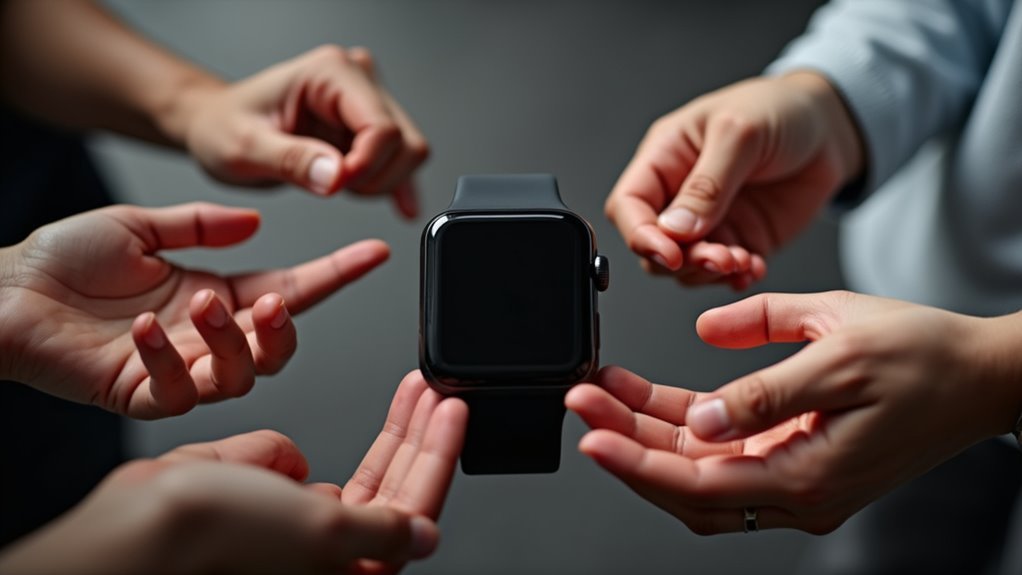
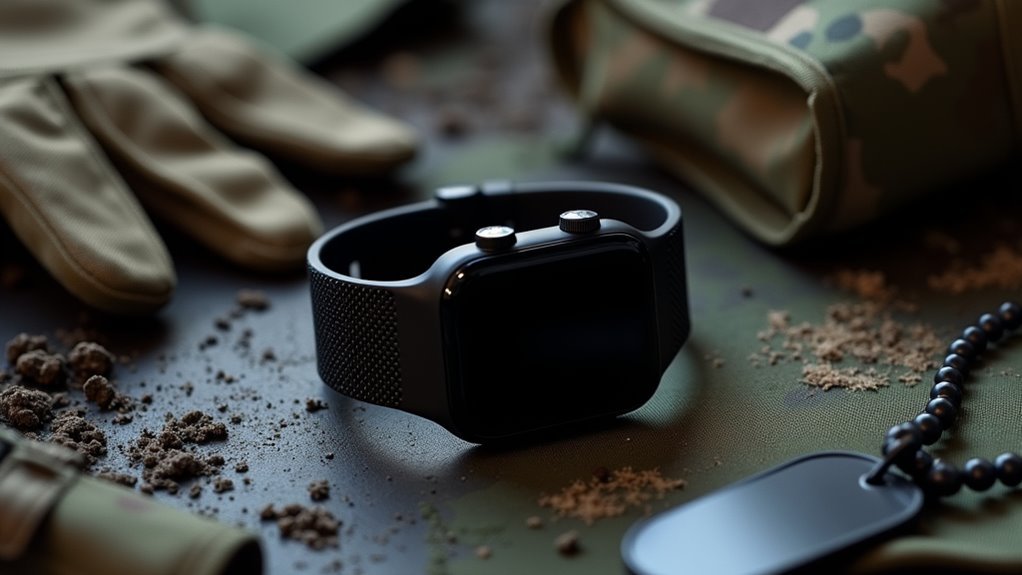
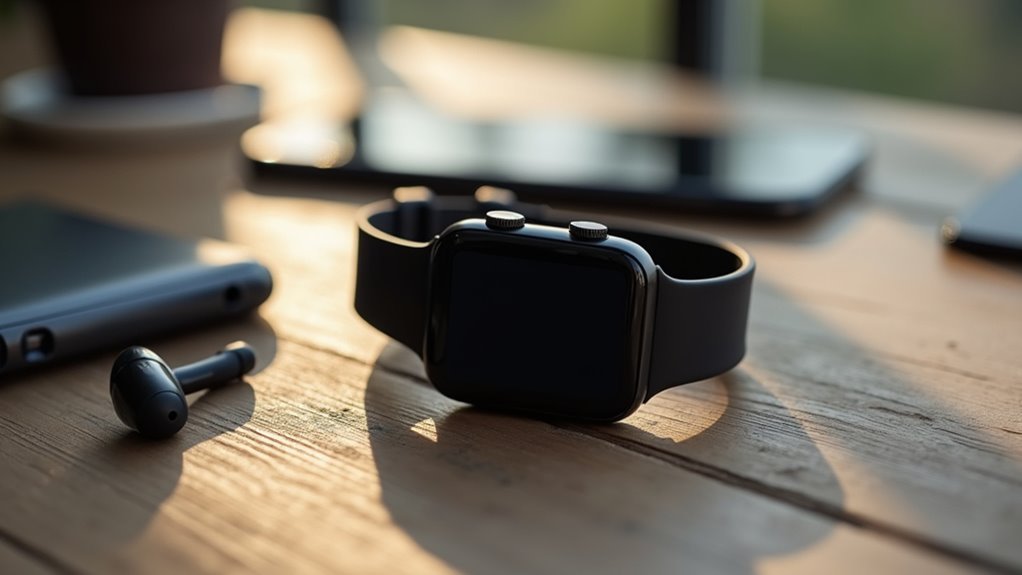
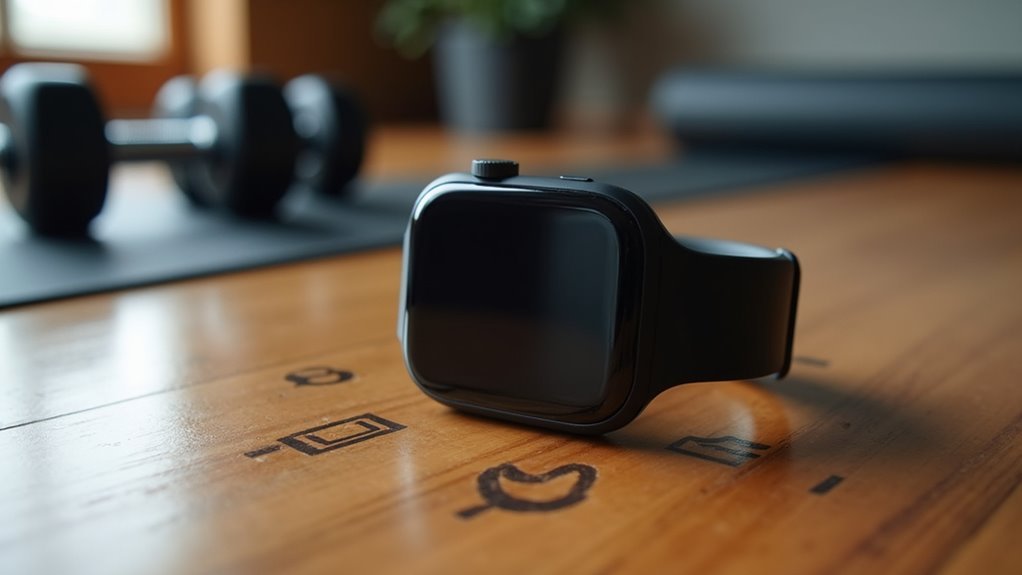
Leave a Reply